Mental Health & Learning Disability Inpatient Bed Census, 2014 - Patients Treated Outwith NHS Scotland
Additional analysis to the results of the first Mental Health & Learning Disability Inpatient Bed Census, focusing on patients treated outwith NHS Scotland.
This document is part of a collection
1. NHS Scotland-funded inpatients receiving treatment out with NHS Scotland
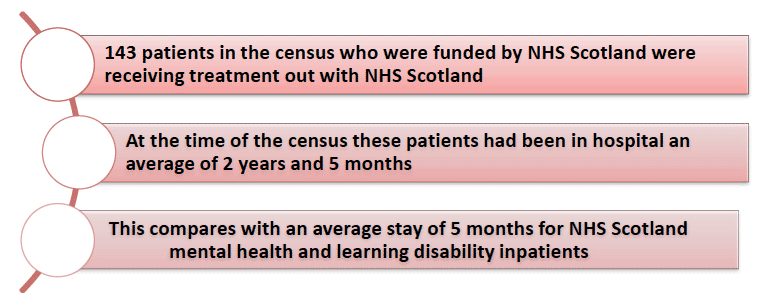
Patients classified in the census as being "Outwith" the NHS are every mental health, learning disability or addiction patient who NHS Scotland funds, but are treated either out of Scotland (e.g. by NHS England) or out of NHS (e.g. in a private/voluntary/local authority care home or private hospital).
In total there were 143 mental health or learning disability patients treated outside NHS Scotland. Of these 143 patients, 96 were treated in a non-NHS facility in Scotland, while 47 were treated in England. Table 1 shows the number of patients by the health board responsible for funding their treatment:
Table 1: Patients treated Outwith NHS Scotland, by NHS Board responsible for funding treatment
| NHS Board responsible for funding |
Patients treated out with NHS Scotland |
|---|---|
| NHS Ayrshire & Arran |
34 |
| NHS Borders |
* |
| NHS Dumfries & Galloway |
10 |
| NHS Fife |
* |
| NHS Forth Valley |
* |
| NHS Grampian |
18 |
| NHS Greater Glasgow & Clyde |
11 |
| NHS Highland |
* |
| NHS Lanarkshire |
* |
| NHS Lothian |
20 |
| NHS Orkney |
* |
| NHS Shetland |
* |
| NHS Tayside |
16 |
| NHS Western Isles |
0 |
| National Services Division |
* |
| All |
143 |
*Suppressed due to small numbers. See paragraphs on "Data Confidentiality" in Section 2 of this report.
Figure 2 shows the age and gender breakdown of patients treated outwith NHS Scotland. The majority of patients treated outwith NHS Scotland are male; there is also a majority of patients who are of working age (between 18 and 64). The gender split for under 18s cannot be shown here due to small numbers (see paragraphs on "Data Confidentiality" in Section 2 of this report).
Figure 2: Patients treated outwith NHS Scotland, by age and gender
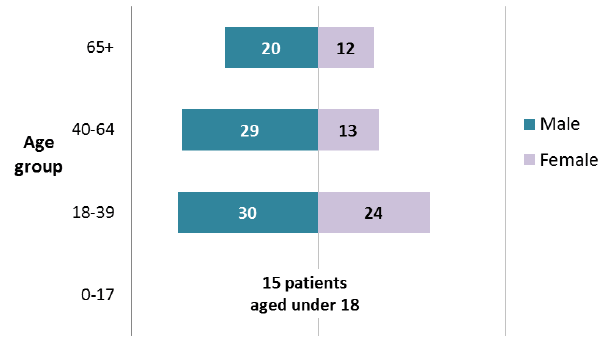
The average (median) number of days for the 143 patients treated outwith NHS Scotland was 2 years and 5 months - this is more than five times longer than that of those patients treated within NHS Scotland facilities (Table 2).
Table 2: Average number of days since admission at time of census: patients treated outwith NHS Scotland v patients treated by NHS Scotland
| Group |
Average (median) number of days since admission |
Approx. number of years / months |
|---|---|---|
| NHS Scotland patients treated outwith NHS Scotland |
885 |
2 years, 5 months |
| All NHS Scotland patients (excluding 'outwith' patients) |
160 |
5 months |
While Table 2 shows that the average time in hospital for patients treated outwith NHS Scotland was around 2 years and 5 months, Figure 3 (over page) shows that the time spent ranges from less than 3 months (13 patients) to 5 years or longer (42 patients):
Figure 3: Patients treated outwith NHS Scotland, time since admission
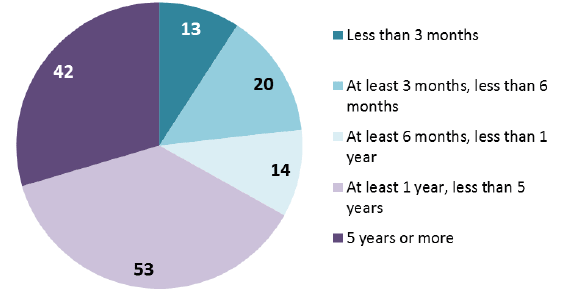
It should be noted that part of the reason why patients treated outwith NHS Scotland have longer hospital stays is that there is a higher proportion of patients a Learning Disability or Autism diagnosis than for patients treated within NHS Scotland; patients with a Learning Disability or Autism tend to have longer hospital stays than other mental health patients (Table 3).
Table 3: Average number of days since admission at time of census for patients treated outwith NHS Scotland: patients with a Learning Disability or autism diagnosis
| Patients treated outwith NHS Scotland |
Average (median) number of days since admission |
Approx. number of years / months |
|---|---|---|
| Patient has a learning disability or autism diagnosis |
1,672 |
4 years, 8 months |
| Other patients |
664 |
1 year, 10 months |
Of the 143 mental health, learning disability or addiction patients treated outwith NHS Scotland:
- 44 (31%) of patients were under Forensic Services. 33 out of the 44 patients under Forensic Services (75%) were male. A small number (less than 10) of the 44 patients under Forensic Services had a diagnosis for a Learning Disability or Autism.
- 93 patients were under "General Observation", while 16 patients were under "Constant" or "Special" observation (for 28 patients this question was "not applicable", observation data was missing for 6 patients).
31 out of the 143 patients had a diagnosis, either primary or secondary, for a Learning Disability (22% of all patients). This was the most prevalent condition amongst the 143 patients; 26 patients had a Personality Disorder, 25 had Schizophrenia and 21 had Dementia. The figures for a range of mental health conditions are shown in Figures 4 and 5 (over page):
Figure 4: Patients treated outwith NHS Scotland - Mental Health diagnosis (primary and secondary)
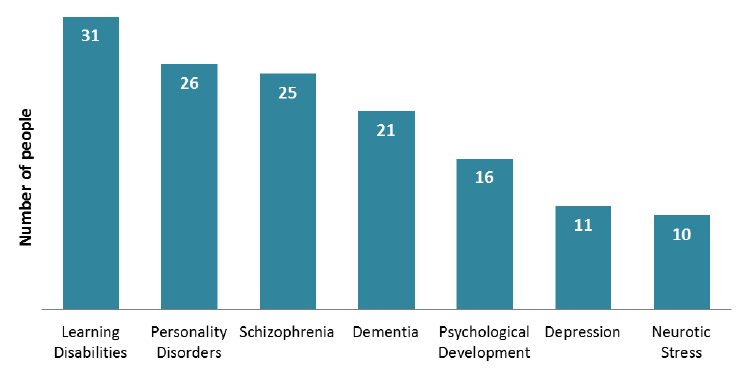
Note: 32 patients had 'other' mental health diagnoses and 18 patients had 'missing' diagnosis information.
Note: Patients can have multiple conditions.
Figure 5: Patients by MH diagnosis type, as % of all patients treated outwith NHS Scotland
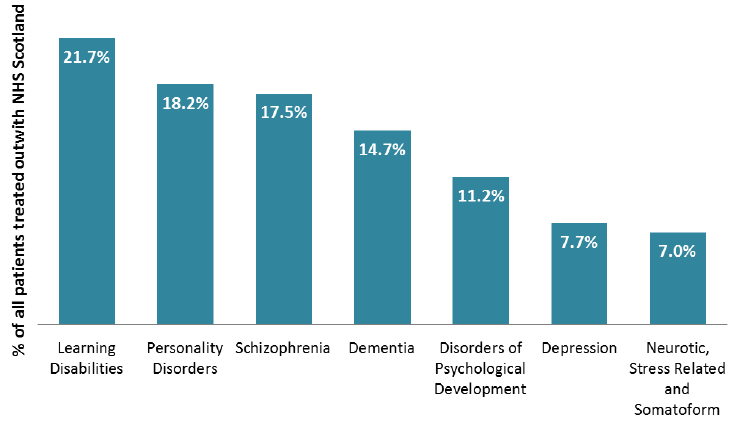
Note: Patients can have multiple conditions.
Contact
Email: David Scott
There is a problem
Thanks for your feedback